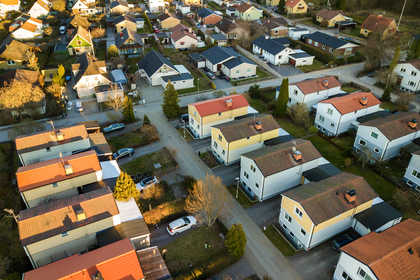Exploring New Neighbourhoods: Tips for Finding Your Community
Finding the perfect neighbourhood is key to feeling at home. If you don’t love the neighbourhood, will you ever really feel at home? Discovering a place where you belong and a house you can call home isn’t easy. However, by researching what makes a neighbourhood a community and looking for those core values in different areas, you can find both in no time. Today’s blog will help you find your community and home within it by discussing what makes a great neighbourhood and sharing tips on how to apply this knowledge to find the right home. We’ll even discuss telltale signs you’ve found the right house. Keep reading to learn it all.
What Makes a Great Neighbourhood?
While what makes a great neighbourhood might differ from person to person, there are some features that are commonly sought-after:
- Safety. The best neighbourhoods are safe. In these areas, there are low crime rates, most people know each other, and there’s a strong commitment to family values, ensuring the neighbourhood remains safe and secure for everyone.
- Convenience. Imagine finding everything you need right outside your front door? By looking carefully, you can discover the perfect neighbourhood with convenient amenities such as parks, schools, grocery stores and more – all within walking distance!
- Sustainability. Green spaces with trees and vegetation can greatly enhance a neighbourhood’s character and value. They also benefit the environment by improving air quality, reducing the risk of flooding, creating shade, lowering temperatures and providing habitats for endangered local wildlife.
- Accessibility. Well-designed neighbourhoods offer easy access to various amenities and facilities, including public transportation, healthcare centres, schools, grocery stores and more! Having these essential services nearby provides a sense of convenience and accessibility that enhances daily life.
- Welcoming Neighbours. You could have the best amenities and live in the nicest part of town, but still feel like something is missing. That missing piece is the people! Your neighbours bring life to the neighbourhood you’re settling into, and they can make or break your experience. Welcoming neighbours help you feel comfortable and familiar, easing you into your new surroundings.
What Makes a Neighbourhood a Community?
Whether you live in a townhouse, an older neighbourhood or a new development, your neighbours are part of your life. Together, you form a tight-knit community, sharing local resources like parks and grocery stores and addressing common concerns like safety and street maintenance. Being a resident here fosters a sense of belonging and community. This bond is essential in making neighbourhoods great, enhancing the quality of life for everyone involved.
Steps in Finding the Perfect Neighbourhood
Step 1: Identify Your Priorities
Before you start exploring and evaluating neighbourhoods, it’s important to define what makes a neighbourhood great for you. Consider the features and qualities that matter most to you. Rank them from essential must-haves to nice-to-haves. Here are some initial questions to help you get started:
- Do you have children or plan to in the future? If you’re a parent, one of your top priorities should be researching the local school system. Even if you don’t have kids yet, living near a highly regarded school district can increase your property value. Additionally, if you have a family or plan on starting one, consider the availability of parks and community centres.
- How far will you commute? Knowing your daily commuting limit is essential when searching for a new home. Determine if you prefer driving, walking or using public transit for your daily commute to work.
- Do you prefer historic or modern neighbourhoods? Each has its own appeal. Historic areas offer charm and character, but often need more maintenance. Newer developments come with modern amenities but tend to be smaller in size.
- What do you believe your existing community is lacking? There’s a reason you’re seeking a fresh start. What’s driving it? Whether it’s the desire to live near the water, closer to shops, or something else entirely, pinpointing this reason will guide you in finding the perfect neighbourhood.
- Is travelling on foot important to you? Walkability is becoming an increasingly important feature for homeowners. Deciding whether you want shops and restaurants within walking distance or are fine with driving to nearby businesses is key when selecting a neighbourhood.
- Consider what you don’t want in a neighbourhood. If you’re bothered by late-night noise, living away from bars could be a smart choice. Being honest about what you don’t like is crucial since you’ll probably be living there for a long time.
Step 2: Research Different Neighbourhoods
If you’re moving within the same city, you might already be familiar with the different neighbourhoods. Focus on the ones that match what you’re looking for in a property. If you’re relocating to a new city, province, or even country, you’ll need to do a bit more research to get acquainted with the area. Start by choosing a specific area to investigate. A good strategy is to begin near your workplace. In large urban spaces, narrow down your search to a few blocks. Once you’ve chosen a part of the city, start gathering information. Check out neighbourhoods online, ask local real estate agents for recommendations and gather information on the following:
- Schools: Research the local public and private elementary schools, high schools and daycare programs.
- Crime statistics: Enter the postal code online to compare its crime rates with the national average. For detailed information, contact the local police station directly.
- Parks and recreation: Check the proximity of the nearest park or recreation centres for each of the neighbourhoods you’re researching.
- Tourist attractions: If weren’t born and raised in the city you’re researching, consider looking up a guidebook or visiting the city’s tourism website to explore its attractions.
- Neighbourhood associations: Find out if the community you’re interested in has a neighbourhood association. If it does, inquire about any lawn or construction restrictions and whether there’s an annual fee.
Step 3: Visit Neighbourhoods
Once you’ve finished your research, it’s time for a field trip to see if these neighbourhoods live up to your expectations. During these initial visits, many thoughts will race through your mind. Engage your senses to gain a comprehensive picture of what each community offers. Use your sight to capture first impressions. Notice if the houses are well-maintained and if the shops and restaurants look modern and inviting. Also, watch for signs that the neighbourhood may be struggling, such as abandoned buildings, vandalism, or numerous “For Sale” or rental signs, as these can affect your home’s value. Rely on your sense of smell to detect any off-putting odours in the vicinity. Does it smell fishy or just generally unpleasant? Either way, such scents aren’t conducive to a perfect neighbourhood. Lastly, talk to neighbours and locals to gauge their thoughts on the area. Ask if there’s anything they would change and listen closely to their feedback.
Step 4: You’ve Found Your Perfect Neighbourhood – Now, Find the Right Home
Now that you’ve narrowed in on the perfect neighbourhood, the fun part begins – finding the right home. It’s important to choose one that aligns with your budget. After all, you don’t want to struggle financially, eating only Mr. Noodles and Kraft Dinner for the next 15 to 30 years. Compare various loan options and decide on the mortgage type that best suits your situation. Also, think about the features you want in a home and create a clear vision to guide you as you begin house hunting.
Signs You Found the Right House
- Meets Home Inspection Standards: One clear sign that you’ve found the right house is passing a home inspection. This provides peace of mind because even though a house might look good at first glance, there could be hidden problems lurking beneath the surface.
- It just feels right. Sometimes, intuition speaks louder than logic. Trust your gut feeling about a home. Understanding why it feels right can reveal what aspects appeal to you the most.
- You’re envisioning future arrangements. If you’re already planning where your furniture will go, it’s a good sign you’re drawn to the space. Imagining yourself living there indicates it might be time to make an offer.
- No interest in viewing other homes. While touring different properties can be exciting, it can also be fairly taxing, taking up your time and energy. if you find yourself fixated on one particular home rather than exploring new options, it’s likely you’ve found your match.
- The home has good bones. No house is perfect, but if the structural aspects meet your needs and any necessary changes are cosmetic (like paint colours or tile choices), you might have found your next home.
Step 5: Hire a Trusted Moving Company like Bird’s Moving & Storage!
You’ve found the perfect neighbourhood and your dream home– all that’s left is choosing an experienced moving company to get you there. With a history dating back to 1933, Bird’s Moving & Storage has the expertise to transport your belongings safely. Whether it’s a local move, long distance or international, our professional team ensures a smooth relocation. Discover why we’re Niagara’s largest and most trusted moving company. Contact us today to learn more about how we can assist with your upcoming move.





